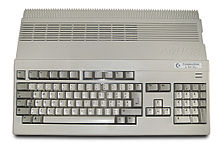The Amiga Consoles: A Powerful Legacy in Computing and Gaming
The Amiga line of personal computers, developed by Commodore International, left an indelible mark on the computing and gaming world during the 1980s and 1990s. Renowned for their advanced graphics and sound capabilities, the Amiga consoles became a popular choice for both gamers and creative professionals. In this article, we will explore the different Amiga models, their performance in the market, and the lasting legacy they left behind.
The Amiga Line-Up
- Amiga 1000 (1985): The Amiga 1000 was the first model in the series, featuring a Motorola 68000 CPU, 256KB RAM (expandable to 512KB), and a custom chipset for graphics and sound. The Amiga 1000 was primarily aimed at the high-end market and was embraced by creative professionals for its multimedia capabilities.
- Amiga 500 (1987): The Amiga 500, a more affordable and accessible model, became the best-selling Amiga computer. It featured the same CPU as the Amiga 1000, but with improved graphics and sound capabilities, making it highly appealing to gamers. The Amiga 500 boasted an extensive library of games, including classics like Lemmings, The Secret of Monkey Island, and Shadow of the Beast.
- Amiga 2000 (1987): Released alongside the Amiga 500, the Amiga 2000 was targeted at the professional market. With an expandable architecture and a range of peripheral options, the Amiga 2000 was a versatile machine suitable for various professional applications, such as video production and graphic design.
- Amiga 3000 (1990): The Amiga 3000 introduced the Motorola 68030 CPU and AGA (Advanced Graphics Architecture) chipset, offering enhanced graphics and processing power. The Amiga 3000 was geared towards the high-end market, but it struggled to compete with the rise of IBM-compatible PCs.
- Amiga 600 (1992): The Amiga 600 was a compact, cost-reduced version of the Amiga 500, featuring an internal IDE hard drive interface and PCMCIA slot. However, due to its limited expandability and performance improvements over the Amiga 500, the Amiga 600 was not as successful in the market.
- Amiga 1200 (1992): The Amiga 1200, one of the last models in the series, was a more powerful successor to the Amiga 500. It featured the AGA chipset, a Motorola 68020 CPU, and 2MB RAM. Despite its improved capabilities, the Amiga 1200 faced stiff competition from IBM-compatible PCs and the emerging 16-bit game consoles.
Market Performance and Legacy
At their peak, the Amiga consoles enjoyed considerable success, particularly with the Amiga 500, which sold millions of units worldwide. The Amiga line was praised for its advanced graphics and sound capabilities, making it a popular choice for gamers and creative professionals.
However, as the 1990s progressed, the Amiga struggled to compete with the rapidly advancing IBM-compatible PCs and the rise of 16-bit game consoles like the Sega Genesis and Super Nintendo. Commodore ultimately filed for bankruptcy in 1994, signaling the end of the Amiga’s mainstream presence.
Despite its decline, the Amiga’s legacy lives on through a passionate community of enthusiasts who continue to use and develop for the platform. The Amiga also left a lasting impact on the computing and gaming world through its pioneering multimedia capabilities, setting the stage for future advancements in graphics, sound, and hardware design.
